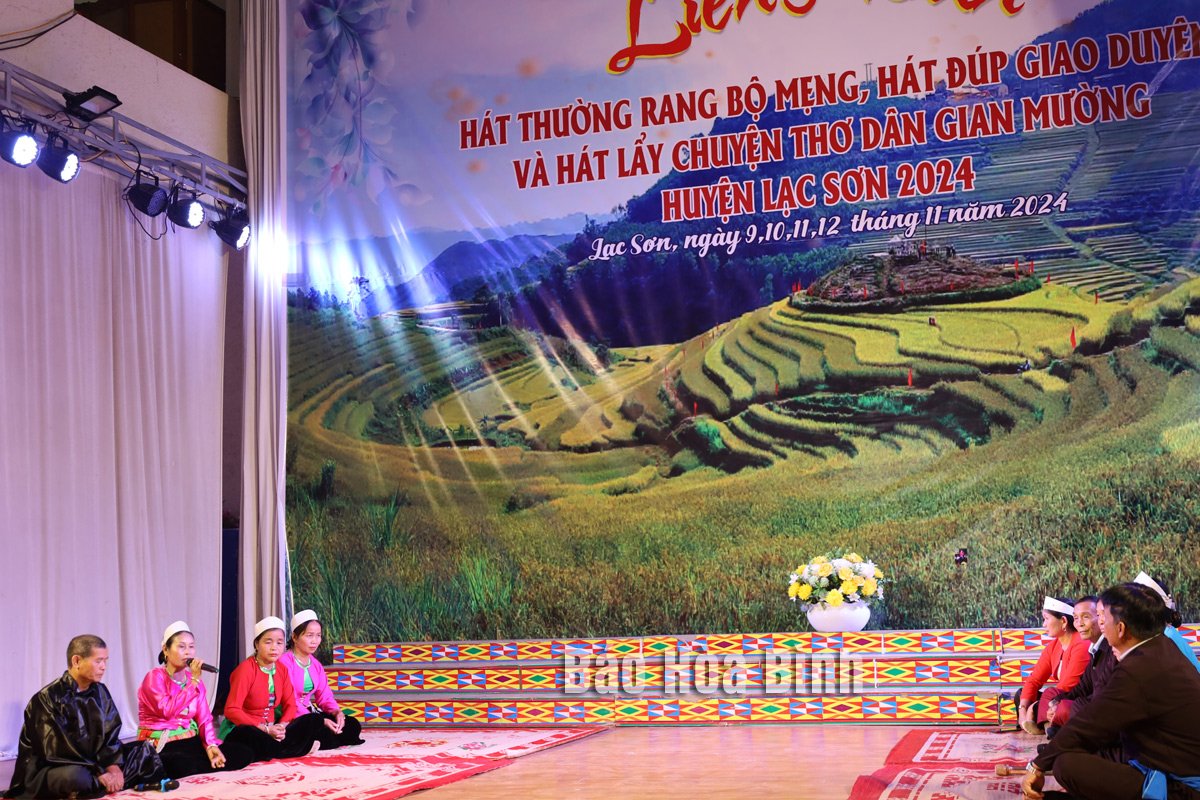
Along with the activities of Project 6 - the national target programme for socio-economic development in ethnic minority-inhabited and mountainous areas for the 2021 – 2026 period, efforts to preserve and promote the traditional cultural values of ethnic minorities in Lac Son district have received additional momentum.
A love duet singing contest at a singing festival in Lac Son district in 2024.
Lac Son district’s authority has hosted the first Thuong Rang and Bo Meng, and love duet singing festival in November 2024, attracting over 300 artisans from communes, towns and Muong folk song clubs.
Bui Thi Tanh, a member of the Muong folk song club in Dinh Cu commune, said that the festival offered an opportunity for participants to exchange experiences in preserving and promoting the national cultural identity.
Building on the success of the festival, the district organised a training programme and competitions in "Danh mang” (folk game) of the Muong people, "Sec bua" ritual, and Muong gong performance, creating a joyful atmosphere during the festival.
According to Bui Thi Tham, Director of the district Culture, Sports and Communication Centre, "Thuong rang bo meng” and love duet singing, Muong gong performance, and "Danh mang” are typical cultural heritages of the Muong people in the Muong Vang area.
In recent years, local authorities have regularly paid attention to implementing solutions to preserve and promote traditional cultural identity of the locality through creating spaces and practice environments in festivals; great national solidarity festivals; and art, cultural and sports competitions at the grassroots level, Tham said.
The generations of artisans are encouraged to promote their role as heritage keepers, and actively pass it on to the next generations, Tham said, adding that with the support of Project 6, the contents and activities are systematically and attractively built, attracting a large number of artisans and locals, contributing to spreading the love for the nation, and preserving good customs and practices, and the cultural identity of the Muong ethnic group.
Comrade Bui Van Duong, Vice Chairman of Lac Son district People's Committee, said that the district focuses on restoring and organising traditional Muong ethnic festivals; establishing and maintaining the operation of traditional culture preservation clubs at the grassroots level; and investing in upgrading, repairing, and embellishing relic sites.
Through the support of Project 6, the district Party Committee and People's Committee organised a gathering for artisans, researchers, collectors, composers, and those involving in traditional cultural preservation; and opened classes to raise public awareness of cultural heritages at risk of being lost.
Attention has been paid to conducting inventories, documentation, and classification of heritage types for research activities, Duong added.
In 2024, through Project 6, 50 ethnic minority-inhabited hamlets in the district have been supported to purchase equipment for communal houses; restore, preserve, and promote traditional cultural identities of ethnic minorities; continue to survey, collect and document heritage; preserve traditional festivals; develop policies for assisting artisans; and build traditional culture models, typical tourism areas, contributing to preserving heritage, satisfying the demand for cultural enjoyment in the community.
The People’s Committee of Lac Son district held a ceremony on April 28 to receive the provincial relic certificate for the ancient rock carving site at Suoi Co stream, located in My Thanh commune.
A special music show titled "The country is in the fullness of joy” has been held at Hoa Binh Square in Hoa Binh city in celebration of the 50th anniversary of the liberation of the South and national reunification (April 30, 1975–2025).
The People's Committee of Lo Son commune, Tan Lac district, has organised the local annual traditional stream fishing festival on April 19 - 20.
As a land deeply intertwined with human history and Vietnam’s millennia-long journey of nation-building and defence, Hoa Binh is often revered for its epic tales and legends.
Residents of Hoa Binh boast a rich cultural identity, reflected in their unique language, traditional attire, customs, and folk melodies – described as "sweet as honey, clear as a mountain stream.”
Lac Son district’s Vu ban town held the 2025 Truong Kha temple festival on April 12–13 (the 15th–16th days of the third lunar month). Since its revival in 2019, the festival has been organised every three years, preserving valuable intangible heritage while meeting the community’s cultural and spiritual needs.



